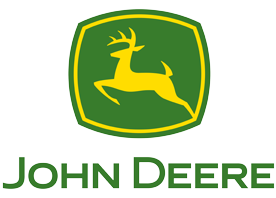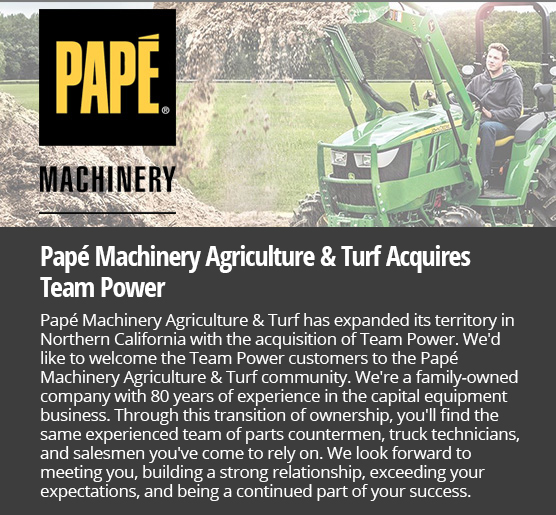
CP690 Cotton Picker
- John Deere
- Agriculture
Find Your Nearest Location
Key Features & Specs
- Improved non-stop round module harvesting with 4.4 mph max row unit sync speed
- 13.5L Tier 4 engine with 590 peak horsepower
- Next generation ProDrive™ with anti-slip regulation
- New Premium LED lighting package

- + Expand All
- - Close All
-
Round module weighing affords expanded capabilities

Round module weighing is standard on all CP690 Cotton Harvesters and provides real-time feedback on module weight during harvest. Operators will appreciate the added capabilities afforded by this system, such as easier yield monitor calibration. Round module weighing teamed with Harvest Identification, Cotton Pro provides the ginner with recorded module weights to be loaded into their system. Gins without scales will be able to use the module weights to provide turnout data to the producer.
Theory of Operation:
Round module weighing process starts when the round module ejects from the module builder onto the handler. Once the handle automatically moves to the carry position the module weight is displayed on the CommandCenter™ display and displayed and documented in the GS3 2630 if the harvester is equipped with Harvest Identification, Cotton Pro.
-
Round module moisture sensing ensures fiber quality
 Moisture sensor
Moisture sensorThe moisture sensor on the CP690 Cotton Harvester provides on-the-go, real-time moisture measurement on which operators can rely. The moisture sensor is mounted on the round module builder which reads cotton moisture levels as the round module is being formed.
Customer value:
- Real-time data to help preserve cotton quality
- Module moisture documented in Harvest Identification, Cotton Pro
- Industry-leading accuracy in the critical 9 – 13 percent moisture range
Ginning value:
- Maximizes ginning efficiency through module moisture tracking
Theory of operation:
The moisture sensor continuously measures the moisture of seed cotton in contact with the moisture sensor during the round module forming process.
-
Simpler, more productive harvest with less labor
 CP690 Cotton Picker
CP690 Cotton Picker CP690 Cotton Picker in transport
CP690 Cotton Picker in transportThe CP690 continues the legacy of exclusive non-stop harvesting technology for increased productivity. Unlike traditional basket pickers, the CP690 provides its own onboard module building system, eliminating boll buggy drivers, module builder operators, and all the supporting equipment traditionally needed during cotton harvest.
Operators who harvest cotton with the CP690 enjoy the fact they never have to wait in the field. A cotton harvesting veteran in the Louisiana Delta said, "Driving a standard basket picker when you are in good cotton, which is the time you really want to move faster, you have to wait on a boll buggy. The operator has to travel all the way back to the module builder, dump that load, and then try to find you again. That whole time you are sitting in the field doing nothing. You are not productive. With the onboard module builder, you are constantly productive. You never have to stop. You keep going and going, and this saves you so much time throughout the day."
Increased productivity
The nonstop harvesting of cotton is achieved through the use of a high-volume accumulator, round module builder, and round module handler. The accumulator collects cotton while a formed round module is wrapped with a protective film and ejected onto the machine's rear handler. The handler allows a completed round module to be carried to the end of the row.
Since round modules are formed, ejected, and can be off-loaded while the CP690 is still harvesting, the operator can remain on the row instead of unloading or waiting to unload cotton into boll buggies or module builders.
Reduction of labor
It can be difficult acquiring good labor to be able to keep multiple cotton pickers, boll buggies, and module builders up and running. With the CP690, harvesting cotton simply requires one operator per machine, and one tractor operator to stage modules for transport. Additionally, since each round module is wrapped with a protective film, they do not require the application of a module tarp for field storage protection. The CP690 helps reduce the risks associated with finding labor, enabling producers to have more efficient and less labor-intensive harvesting operations.
One Louisiana Delta producer was excited about the labor savings the on-board round module building system would bring to his operation. He was able to take his existing picking fleet down from six machines to four machines and significantly reduce the support staff that goes along with them. With a traditional fleet, he was running 22 to 24 people on any given day, but could likely reduce that number to about seven.
Reduction of support equipment
Typically each basket-style stripper requires a fleet of support equipment to achieve maximum harvest productivity:
- Boll buggy
- Boll buggy tractor
- Module builder
- Module builder tractor
The CP690 requires only two pieces of support equipment:
- Frontier™ CM1100 Cotton Module Handler (or equivalent)
- 8000 Series (or equivalent) Row-Crop Tractor
These two pieces of equipment are used to stage round modules end-to-end in groups of four, so they may be picked up by a module truck. Producers and ginners also have the flexibility to haul the round modules on flatbed trailers, providing the opportunity to haul more pounds per load for reduced transport costs. Since modules can be staged any time, day or night, one tractor and CM1100 Cotton Module Handler can support multiple CP690 Cotton Pickers.
This reduction in support equipment means less equipment and traffic in the field and less fuel consumption. The CP690 not only creates a simplified harvest scheme, it helps reduce frustration that producers face while having to contend with traffic on increasingly busy roads.
-
Conserve fiber quality with 360 degrees of protection
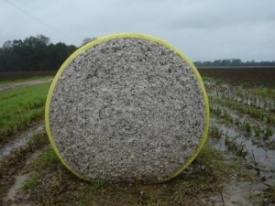 Round module
Round module Conventional module
Conventional moduleA combination of high winds and rain can damage cotton whether in the field or at gin yards. With the fixed, 2.44-m (8-ft) wide round modules, producers and ginners receive 360 degrees of protection, creating a unique shape that keeps cotton from wicking moisture that can reduce crop quality.
Modules are wrapped three times within the CP690's on-board module builder, ensuring cotton fiber and seed protection. Each portion of wrap contains two segments of linear low-density polyethylene (LLDPE) film. A non-tacky layer is followed by two tacky layers to keep the round modules in a uniform shape and provide protection from dust and rain.
The Z-Lock™ with dual tail adhesive system ensures the tapered end of the wrap is secure in high winds and rain.
 CP690 Cotton Picker
CP690 Cotton Picker
Producers have been impressed by the round modules' ability to preserve the cotton fiber and quality. One south Texas coastal producer harvested his entire south Texas cotton crop with an on-board module building picker. He shared, "The regular modules always have a bale or two on each end that will be a grade difference in color, and they also lose sometimes 10 to 15 percent of the cotton down on the ground. If you have got 25 cm (10 in.) to 30 cm (12 in.) of rain on the regular module, the module trucks just have to shave it off. And that cotton is still sitting out on the gin yard when the ginning is over; it's hard to determine how much we actually lost. In our round modules, we had zero loss this year."
With no lost cotton, this producer was able to harvest his entire crop and have it arrive at the gin feeder floor, ready to be ginned. No other cotton harvesting system available on the market today can deliver all of a producer's crop from the field to the gin floor.
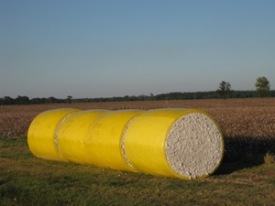 Round modules waiting to be loaded
Round modules waiting to be loaded CP690 harvesting
CP690 harvestingProducers are not the only ones who see benefits in weather resilience with round modules; ginners are also enjoying the benefits. A veteran ginner in North Carolina, with much experience ginning, both round and traditional modules, shared the following observation, "Once the cotton is in these round modules, it is safe. You do not have to worry about weather. You do not have to worry about time. It seems like the longer they stay in there, the better they gin."
Z-Lock is a trademark of Tama Plastic Industry. -
Harvest Identification (ID), Cotton Pro tracks round modules from the cab
 Round module information displayed in John Deere Operations Center Field Analyzer
Round module information displayed in John Deere Operations Center Field AnalyzerHarvest Identification, Cotton Pro is the next generation of round module tracking. Features include the documentation of module moisture, weight, editable comments, and other features listed below. Harvest Identification, Cotton Pro links to John Deere Operations Center Field Analyzer tool to visually display module created locations on the yield map along with providing individual module information.
More information about the integration of Harvest Identification, Cotton Pro with John Deere Operations Center is available here.Harvest Identification, Cotton Pro Monitor

Harvest Identification, Cotton Pro incorporates new features that allow producers to better manage their cotton harvest data for agronomic decisions. Expanded operational features on the GreenStar™ 3 (GS3) 2630 include automatic module serial number, module notifications, comments, module history, field file sorting, and season counter reset.
The automatic module serial number feature will fill in a missed module serial number if the RFID tag did not document in the Harvest Identification, Cotton Pro monitor and file. This feature reads the previous module serial number and the serial number of the module after the missed module and automatically completes the missing serial number if it detects sequential serial numbers. In addition to the automatic serial number feature the serial number field on the GS3 2630 is editable allowing the operator to add a serial number manually.
Module notifications alert the operator of missing RFID data and potential data loss so the information can be captured and documented while the module is displayed on the GS3 2630. This feature allows the information coming from the harvester to John Deere Operations Center to be complete removing the need to correct data later.
Operators now have the ability to add comments to modules in the GS3 2630 Display while harvesting. This capability allows the producer to manage modules that have a comment and can be used to alert ginners of something specific to the module.
Harvest Identification, Cotton Pro allows operators to view three modules on the GS3 2630 at one time. This flexibility allows the operator to make comments and compare module information while harvesting in the field.
Producers now have the flexibility of creating specific Harvest Identification, Cotton Pro files to meet their needs. A producer can create any one or multiples of the following files; Master data file (standard), client data file, field data file, producer ID data file, gin ID data file. These files allow a producer to manage data for custom harvest producers, by the field, by producer ID, and/or by gin ID. These files shorten the time a producer spends reviewing data.
Harvest Identification, Cotton Pro Theory of Operation
The backbone of John Deere Harvest Identification, Cotton Pro is the radio frequency identification (RFID) tag chip found in each portion of TAMA™ Round Module Wrap (RMW™). This module wrap is currently produced with Impinj® Monza® RFID tag chips embedded in the polyurethane material.
These RFID tag chips give each round module the ability to be recorded and processed as single entities. With this unique characteristic, producers and ginners can generate more specific reports, which could define and link attributes to a production area.
Advantages of linking crop characteristics to a production area:
- Ability to see exactly what crop quality a particular section of the field produced
- Finely adjust application rates or even trace back high leaf grades to defoliation problems
Producers need this type of information to more precisely select varieties with characteristics that would allow them to gain the most value out of their land. Harvest Identification, Cotton Pro is the building block to these ideas. As technology matures, so does the industry.
The information found in the Harvest Identification file includes data relevant to both a producer’s documentation requirements and their ginner’s record keeping system. Data files can be transferred from the machine automatically with Wireless Data Transfer (WDT) included in a JDLink Connect subscription or manually using a USB stick. The chart shows what is automatically entered into Harvest Identification, Cotton Pro and what information is populated through operator input, given that a StarFire™ receiver is installed.
John Deere Harvest Identification, Cotton Pro file inputs
Automatically populated fields
Operator populated fields
Module identification number Client* Module serial number Farm* Module created Latitude Field* Module created Longitude Variety* GMT date Operator GMT time Gin ID Machine serial number Producer ID Local time Field area Season total Module diameter Module moisture Module weight Module drop latitude Module drop longitude Field total Incremental area Local date Comments *Fields will be populated automatically if information is preloaded into GS3 2630 before season and Field Locator is selected.
Module identification (ID) number
The module ID number is used to uniquely identify one module from another. By giving each round module a unique ID number, every module produced has its own description and attributes associated to it. This provides value chain partners the ability to dig deeper into the why and how as it pertains to the production cycle and its effect on quality and output.
Module serial number
The module serial number (SN) is used to give a historical account for each portion of the TAMA RMW. This number is used to identify each portion’s year of production, manufacturing location, and production machine.
Module moisture
Individual module moisture is documented for traceability to the producer and ginner. Module moisture is closely tied to cotton quality which helps the producer know when to start and stop harvesting during their harvest day. Ginners can prioritize ginning for modules with high moisture to preserve both fiber and seed quality.
Module weight
Producers can track individual module weights which eases infield yield monitor calibration. Ginners will appreciate the individual weights for their records, specifically gins without scales.
Incremental area
Incremental area provides the producer measured area between round modules. This area provides increments in the field that can be used to identify opportunities in a particular production zone within the field.
Comments
Harvest Identification, Cotton Pro offers producers the capability to add notes to each individual module from the GS3 2630 Display. This field displays any comments the operator adds while harvesting which can be used by the producer or ginner to track specific modules if needed.
Module created latitude and longitude
These fields provide coordinates on where the module was created, module wrapped, in the machines round module chamber. These two positions help producers identify and/or highlight particular production zones within their operation.
Module drop latitude and longitude
These fields provide coordinates on where the module was dropped in the field to better coordinate module staging activities.
GMT date and time
The GMT time and date was chosen as a global input to represent date and time of module formation.From the producer’s standpoint
John Deere Harvest Identification, Cotton Pro provides the ability to track and record module formation as it occurs in the field. When a module is unloaded from the machine’s round module chamber, its information is sent to a controller by a specifically designed RFID reader. Here the data is compiled with the operator’s production inputs giving the module its unique identity. With this information, producers can isolate round cotton modules based on fields or specific production areas. Once defined, location coordinates can be used to correlate applied inputs to yield performance. Producers do not have this degree of traceability with traditional basket systems, as multiple machines could be feeding one module builder; mixing cotton from multiple field sites into large traditional modules. It is almost impossible to look at characteristics on a per acre basis this way.
Cotton producers have asked for another way to track and tag modules without having to manually go to each individually in the field. Harvest Identification, Cotton Pro gives producers a unique and efficient way to record information from modules one-fourth the size of traditional modules, and it is all done from the machine’s operator seat. Also, with Harvest Identification, Cotton Pro, a producer does not have to wonder how many modules were made in each field. The machine collects that information while also connecting module identification numbers to producer defined inputs; populating a data file that not only can be used for yearly production records but can also be sent to gins as a harvest report.
From the ginner’s standpoint
John Deere Harvest Identification, Cotton Pro provides an avenue for a more robust module tracking and logistical system. By incorporating Harvest Identification, Cotton Pro into the ginning process and utilizing an electronic booking system, organizations will see efficiency increases throughout their operation. From the way production information is entered on the producer side to how gin managers initiate module transport; ginners will see a dramatic improvement in their day-to-day operation.
One part of the system is the actual Harvest Identification file that is sent from the producer to the gin. The other important piece is the RFID tag found in the wrap portions. Radio-frequency identification (RFID) is a leading technology in inventory tracking/verification, as it provides the ability to record real-time activity and product movement. As a wireless non-contact use of radio-frequency electromagnetic fields, any object with an RFID tag chip has the ability to be recorded using RFID readers and antennas.
Like most businesses, cotton gins have product that is constantly moving from one place to another.RFID technology is starting to take the place of the common barcode system as a more efficient and user-friendly way to track inventory. One of the biggest advantages of RFID tracking is the ability to read tags that are not within a line-of-sight or that may be imbedded within an object. When trying to implement an RFID system, the user needs three basic parts: a tag chip, reader hardware, and the supporting software to translate data into a useable format.
From the simple advantage of recording modules as they are made to gins building robust RFID-based tracking systems, the need to know more is beginning to show itself in the cotton industry.
-
Ginning advantages offered only by John Deere
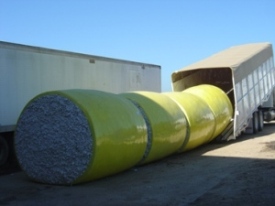 Module truck loading round modules
Module truck loading round modules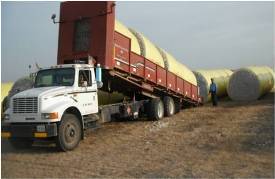 Loading round modules on gin yard
Loading round modules on gin yardThe CP690 Cotton Picker brings advantages to one of the cotton producer’s most important production partners - their ginners.
During the cotton ginning season, ginners are constantly on the go. They coordinate moving modules from fields to the gin yard. They manage the cotton entering the feeder floor and keep the gin running should something break down. While doing all this, they still manage to gin and package 218-kg (480-lb) bales of cotton that are ready to go to a warehouse and ultimately a mill.
In the middle of the cotton harvest season, module trucks can run 24 hours a day trying to collect cotton modules that sit on turn rows. If rain is on the way, module truck drivers may need to change their scheduled routes and go to fields that could be impassable after a deluge to ensure the cotton makes it to the gin yard.
Producers who use traditional modules have only one option to get their cotton to the gin: the traditional module truck. However, producers who generate round modules from their CP690 can move round modules with increased flexibility and multiple methods.
The Frontier™ Round Module Handler allows staging during or after harvest wherever is most convenient or ideal for pickup. After staging, round modules can be moved from the field by standard module trucks (after the inner six chains are changed) or flatbed semi-trailers. Four round modules fit easily in a standard module truck, whereas a 14.6-m (48-ft) flatbed trailer can haul six round modules, and a 16.2-m (53-ft) flatbed trailer can transport seven round modules at a time.
Ginners need not be concerned their module trucks will not be moving as much cotton with four round modules compared to one conventional module. When comparing truck weights at gins, there were no significant differences in the load sizes drivers delivered from the field. Ginners and their module truck drivers can count on increased transportation flexibility when round modules are ginned at their facility.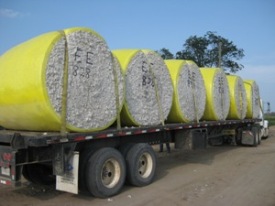 Flatbed trailer with round modules
Flatbed trailer with round modules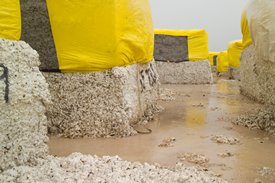 Gin yard (wet conventional modules)
Gin yard (wet conventional modules)Increased flexibility in moving modules from the field to the gin yard is only the beginning of a long list of benefits ginners gain with round modules. Round modules are fully wrapped, minimizing the amount of lost cotton in the field or at the gin yard. For a gin ginning round modules, there is no need for a cleanup crew since there is no lost cotton on the ground. Conventional modules sitting on the ground can wick water off the ground, whereas the fully-wrapped modules keep cotton dry — from the field, to the gin yard, to the gin.
One ginner in a coastal south Texas community had to deal with a very large obstacle during a past cotton harvest: Hurricane Dolly. He recalled, "We had 25 cm (10 in.) to 30 cm (12 in.) of rain across a 10-day period. We ginned round bales in the daytime and the conventional cotton in the evenings. During that period, we measured the amount of gas we were using on both of these, and we had about a 40 percent savings on gas [with the round modules]."
For ginners, that amount of savings can help maintain a gin's profitability. Drier cotton in round modules compared to conventional modules was not a unique occurrence. Gin studies conducted throughout the southern U.S. found that cotton in round modules received better grades and was significantly drier than that stored in traditionally-shaped modules.
A similar story comes from North Carolina, where both round and conventional modules were picked from the same field on the same day. The modules were brought to the gin and over the next 20-day period, both sets of modules received over 279 mm (11 in.) of rain.
It was decided to gin the conventional modules first. The bottoms were skimmed and wet spots were gutted from the modules. After finally getting them to the feed floor, the moisture within a given module ranged from 6 percent to 16 percent. The gin had to significantly turn down the feed rate and turn up the dryer. Finding the right feed and dryer rate was a continuous battle that resulted in a compromised feed rate.
When the round modules were run, module moisture was consistently around 8.5 percent. The gin was able to increase the feed rate to approximately seven bales per hour on average and significantly turn down the burner. The chance of over-drying and associated grade degradation was also reduced because of the constant feed and burner rate.
Reduced static electricity was another advantage seen in some locations. Cotton from round modules tends to flow through the gin easier than cotton from conventional modules due to reduced static electricity. Ginning records have been set when running round modules, partly due to the improved flow through the gin.
Ginners have reported positive results when ginning round modules. They have found the compact, round module design helps reduce cotton loss and quality degradation. The highly engineered wrap provides weather- and element-resistant round modules that preserve the quality of fiber and seed delivered to the gin.
Overall, ginners are pleased with the consistent module size, shape, and reduced moisture levels that facilitate increased throughput at the gin. In addition, the fully recyclable wrap may be sold to recyclers in the area, an extra income for the gin. -
More power to pick in demanding conditions
 CP690 harvesting
CP690 harvesting CP690 harvesting
CP690 harvestingThe CP690 Cotton Picker is a powerful harvesting system - only from John Deere.
With a 418 kW (560 hp) 13.5-L John Deere PowerTech™ PSS Final Tier 4 (FT4) engine, the CP690 packs enough punch to pick in the most demanding conditions. A conventional basket picker can spend 20 percent or more of its time unloading, waiting for boll buggies, or driving back and forth to a module builder. The CP690’s non-stop harvesting system keeps operators where they need to be — in the field, picking cotton.
Producers have been greatly impressed with the engine's power, as well as the added benefit of having the full-time four-wheel drive (4WD) and anti-slip regulation on the CP690. These standard features enable them to harvest while other crews are waiting for the ground to dry. Fuel fill-up
Fuel fill-up
Many ask how frequently one must stop to fill up the CP690 with diesel fuel and the answer is simple: just once a day. And the 61-L (16-gal.) diesel exhaust fluid (DEF) tank will last much longer. The CP690 comes equipped with a 1401-L (370-gal.) fuel tank that allows the operator to fill up the tank while servicing the picker.
When it is time to move from one field to the next, the CP690 offers a transport configuration with a height of 4,356 mm (171.5 in). It moves from harvest mode to transport mode in roughly one minute and allows the operator to easily move down the road at 27 km/h (17mph).
Whether trying to beat a rain coming in, harvesting in tough muddy conditions, or simply moving from one field to the next, the CP690 provides power on which operators can depend.
Dimensions
| Lengths | Overall Length 10.1 m 33.3 ftWheel Base 4.3 m 14.2 ft |
| Heights | Transport Position 4.4 m 14.5 ftFull Height Position 5.2 m 17.2 ft |
| Weights | 6-Row 29,937 kg 66,000 lb |
Hydraulic System
| Pump Type | Pressure 210 bar 3,050 psiFlow 223 L/min 59 gpm Pressure/ flow compensated |
Key Specs
| Engine | Horsepower 417.6 kW 560 hpPower Boost 22.4 kW 30 hp John Deere PowerTech PSS™ 6135HN005 |
| Module Weight | 2,041-2,495 kg 4,500-5,500 lb |
| Module Dimensions | Diameter up to 239 cm 94 in. Width up to 244 cm 96 in. |
| Units Available | PRO-16 |
| Module Shape | Round/cylindrical |
| Bars Front and Rear | 16 front drum, 12 rear drum |
| Spacings | 76.2, 91.4, 96.5, 101.6 cm 30, 36, 38, 40 in. |
| Picking Units Style | In-line spindle-type picking units |
On-Board Module Builder
| Module Shape | Round/Cylindrical |
| Unload on-the-go | Yes |
| Wrap system carrying capacity | 120 Portions |
| Module Dimensions | Diameter up to 239 cm 94 in. Width up to 244 cm 96 in. |
| Module Weight | 2,041-2,495 kg 4,500-5,500 lb |
Power Train
| Cooling System | Rotary Screen YesGround Level Access to Coolers Yes |
| Fuel System | Type Electronic unit direct injectionGovernor ElectronicOn Board Diagnostics Yes |
| Rear Wheel Drive | Yes (full time) |
| Tires | Standard Drive Tire 520/85R42 (20.8R42) R1WOptional Drive Tires 520/85R42 (20.8R42) R2Dual Wheels YesDual Tire Size (Standard) 520/85R42 (20.8R42) R1WDual Tire Size (Optional) 520/85R42 (20.8R42) R2Standard Steering Tire IF580/80R34 (R1W) |
| Transmission | Gears Two rangeField range 1 (4WD) 0-7.1 km/h 0-4.4 mphField range 2 (4WD) 0-8.5 km/h 0-5.3 mphTransport range 1 (4WD) 0-14.5 km/h 0-9 mphTransport range 2 (4WD) 0-27.4 km/h 0-17 mph ProDrive™ automatic-shift (AST) |
| Engine | Horsepower 417.6 kW 560 hpPower Boost 22.4 kW 30 hpDisplacement 13.5 L 824 cu in.Cylinders SixTurbocharged/Aftercooled YesAlternator Dual 200 amp John Deere PowerTech PSS™ 6135HN005 |
| Hydrostatic System | Type Hydrostatic/mechanical drive Wet, multiple disc |
Row Units
| Configurations | Number of Rows SixSpacings 76.2, 91.4, 96.5, 101.6 cm 30, 36, 38, 40 in. |
| Row Guidance | Manual RowSense™ / AutoTrac™ RowSense |
| Picking Units | Style In-line spindle-type picking unitsUnits Available PRO-16Drums TwoBars Front and Rear 16 front drum, 12 rear drumSpindles per Bar 20 (PRO-16)Doffer Pads UrethaneMoistener Pads 20Unit Drive Protection Slip clutch |
Tank Capacities
| Lube | 257 L 68 gal. |
| Fuel Tank | 1,400 L 370 gal. |
| Diesel Exhaust Fluid Tank | 60.5 L 16 gal. |
| Moistener System | Quick Fill Yes 1,363 L 360 gal. |
Additional information
| Date collected | 26-Apr-2018 |


